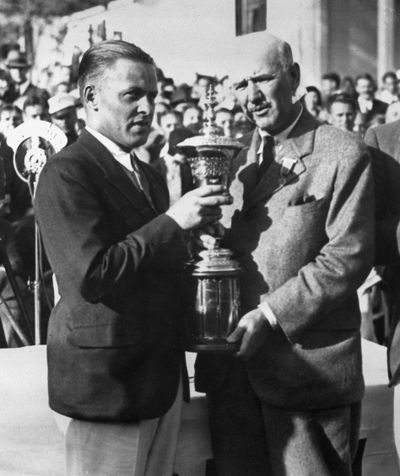U.S. Open returns, tradition remains at Merion

ARDMORE, Pa. – Stop by the rock near the 11th-hole tee box at Merion Golf Club and read up on a slice of sports history.
It’s perhaps the grandest hole in golf.
“On September 27, 1930, And on this hole, Robert Tyre Jones Jr., completed his ‘Grand Slam’ by winning the U.S. Amateur Championship.”
Yes, it was on that hole where Bobby Jones closed out Eugene Homans 8 and 7 in the 36-hole final and clinched golf’s only Grand Slam with a win at the U.S. Amateur.
Merion was a second home to Jones – and perhaps a first love in golf. He was just 14 when he played in the 1916 U.S. Amateur, then went on to win the 1924 Amateur at Merion. And, of course, he completed the Grand Slam in 1930 at age 28, winning the Amateur to go along with the U.S. Open, British Open and British Amateur.
“It’s ‘The Moment’ in the history of golf,” Merion curator Andrew Mutch said.
And one of many landmarks that helped put Merion on the golf map, even if the road back for a major took 32 years. It’s a course that not only includes Jones, but also Ben Hogan and Lee Trevino among its champions.
When Tiger Woods walks the grounds later this week for the first time in a tournament, he’ll follow a compact course that still plays roughly the same as it did a century ago. Perhaps he’ll add the latest unforgettable milestone at Merion if he can win his first major in five years.
Part of the reason Merion is so fondly remembered for its four Opens – think Hogan’s 1-iron on the 18th hole of the 1950 Open – is because there hasn’t been much of a present to relive. At least not for major PGA events.
Not since David Graham closed with a 67 for a three-shot win in 1981, becoming the first Australian to win a U.S. Open, has a major been held at Merion.
So the big moments have had to last at this club tucked away in a tiny Philadelphia suburb.
Before reading the plaques (Hogan has one, too), scan the course to find the wicker baskets, the official symbol of Merion, that dot the course like Q-tips on steroids atop its flagsticks. That’s right, the flag sticks don’t have flags, and the origin of the color-topped pins remains a mystery.
So also is the maker of the baskets. The club guards the secret so tightly that even Mutch insisted he doesn’t know who crafts them.
Would you like some tea with your tee? The first-hole tee box is stuck next to the clubhouse patio, where the tinkling of glasses rings through the air before the first drive of the day, and patrons at the second floor dining room overlook play.
There’s a steep wooden staircase imbedded in a rock quarry on 17 and deep sand bunkers spread out the course that are sure to make play a challenge.
“It’s an architectural treasure,” USGA executive director Mike Davis said. “From a golf standpoint, I think you could easily say it’s a landmark. And there are so many wonderful moments in time.”
Hogan’s 1950 triumph is near the top of the list. A little more than a year after surviving a horrible car crash, Hogan came to the 72nd hole of the 1950 U.S. Open needing a par to force a playoff. In one of golf’s most enduring photos, Hogan is pictured, from behind, hitting a 1-iron from the 18th fairway to a green ringed by spectators. He went on to two-putt for par and won a three-way playoff the next day.